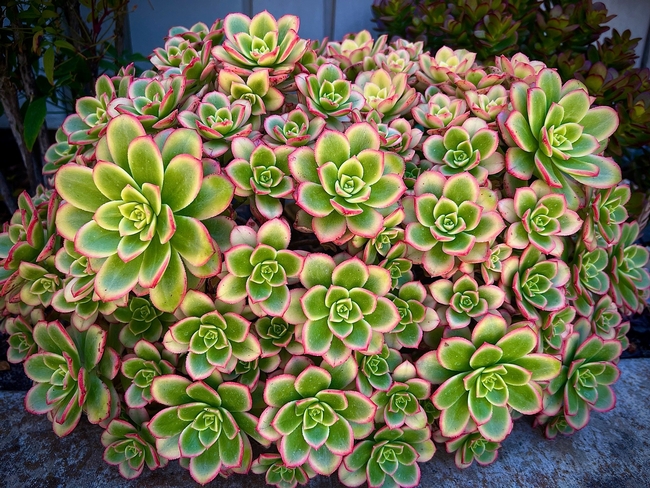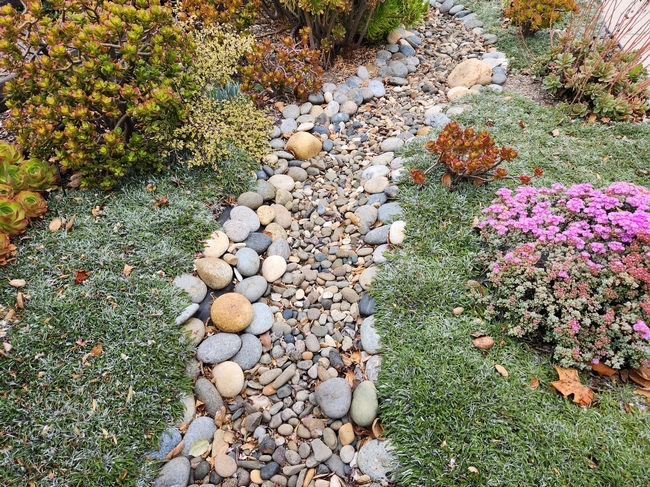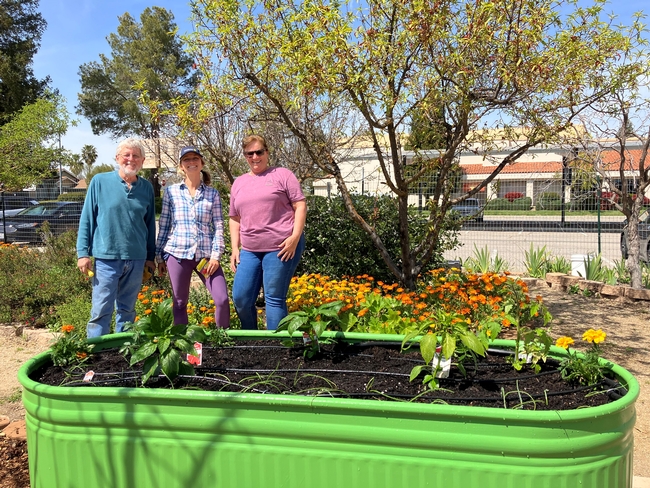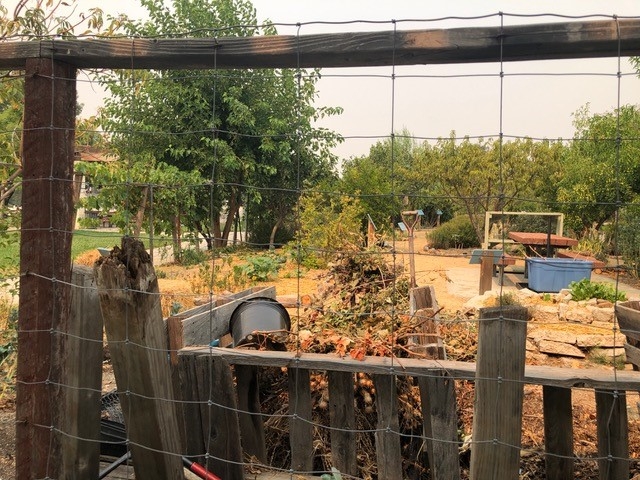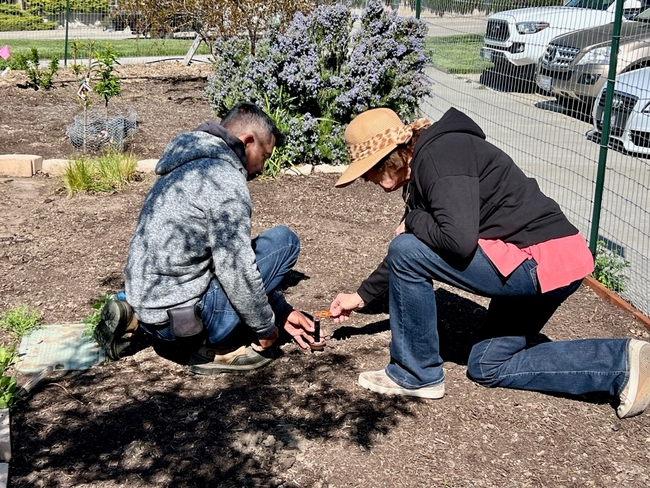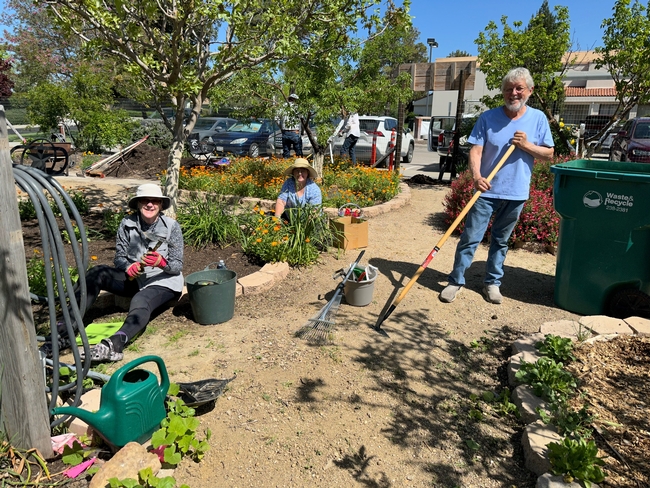- Author: Tami Reece
- Editor: Noni Todd
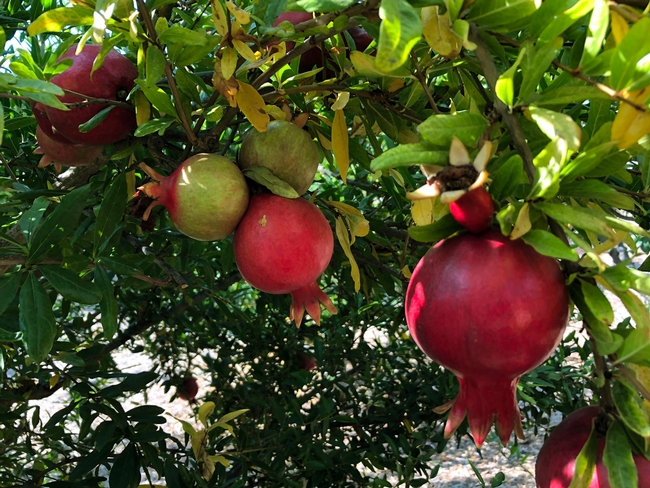
Pomegranate
By Tami Reece UCCE Master Gardener
Common name of plant: Pomegranate
Scientific name: Punica granatum
Planting area: Sunset zone 7-10
Size: 12 to 20 feet height and 12 to 15 feet width
Bloom Season: flowers bloom late May to June; fruit ripens September to October.
Exposure: minimum 6 hours full sun.
Pruning needs: prune during dormancy to remove crossing branches and to
open up the center to allow light and air to reach blooms.
Water needs: drought tolerant; however, for good fruit production, irrigate 5 to 6 inches every 10 days.
Snapshot: Pomegranates grow naturally as a shrub but can be pruned into small trees. Pomegranates are deciduous in the interior and desert areas. Along the coast, they may lose only a portion of their leaves in the winter. Pomegranates are cold hardy down to 10F when dormant and must be protected from frost in late fall before full dormancy or early spring when it begins to bud. It is adaptable to different soil types, growing best in deep loam, though it will tolerate sandy and clay soils. In wetter areas, they are prone to root decay from fungal diseases.
Pomegranates can be grown from seed but are easier to propagate by cuttings.
The pomegranate fruit is red-purple in color. The husk has two parts: an outer, hard pericarp, and an inner, spongy mesocarp, which comprises the fruit's inner wall where the arils attach. Membranes of the mesocarp are organized as nonsymmetrical chambers that contain richly red colored arils. The number of arils in a pomegranate varies from 200 to almost 1,400. Pomegranate arils are delicious used in savory recipes, baked goods, sprinkled on salads, pressed into juice, or simply eaten fresh, straight from the fruit.
A good variety to add to your garden is the “Wonderful” pomegranate. It produces beautiful, sweet, delicious ruby red arils with the fruit growing to the size of grapefruits. If you are looking for a mid-size tree to add color and beauty to your landscape and fruit to your table, try planting a low maintenance drought tolerant pomegranate tree!
Advice to Grow By Workshops
We have a new garden! The Centennial Park Demonstration Garden will be open to the public for the very first time on Saturday, August 12, 2023, 8:00 to 11:00 a.m. Join us for a free family friendly event. There will be garden tours, meet and greet master gardener volunteers, a kid friendly fun activity, and much more. The garden is located at Centennial Park, 600 Nickerson Dr. Paso Robles. Hope to see you there!
Our next Advice to Grow By Workshop will be August 19th, 2023, at 10:00 to 12:00 p.m. in our Garden of the Seven Sisters Demonstration Garden at 2154 Sierra Way, San Luis Obispo. The topic will be “Fire Safe Landscaping.” The workshop is free and open to the public. Docents will be available after the workshop until 1:00 pm. If inclement weather, the workshop will be canceled.
You can view workshops on Instagram live at slo mg or visit our You Tube channel at “San Luis Obispo County UC Master Gardeners.”
Visit our website at ucanr.edu/sites/mgslo/ or email questions to anrmgslo@ucanr.edu.
UCCE Master Gardener Helpline offices:
San Luis Obispo: 805-781-5939 (Monday and Thursday 1:00 to 5:00)
Arroyo Grande: 805-473-7190 (Wednesday 10:00 to 12:00)
Templeton: 805-434-4105 (Wednesday 9:00 to 12:00)
- Author: Ardis Neilsen
- Editor: Noni Todd
Aeonium
By Ardis Neilsen UCCE Master Gardener
Aeonium haworthii ‘Kiwi' - an award- winning succulent
Common Names: Aeonium kiwi, pinwheel, tree houseleek, Irish rose
Scientific Name: Aeonium haworthii ‘Kiwi'
Planting Area: USDA 9-11
Size: width 2-3 feet, height 2-3 feet
Growing Season: perennial, year around
Exposure: full sun to partial shade
Pruning Needs: to maintain shape and propagate
Water Needs: moderate
Aeonium haworthii ‘kiwi,' an award-winning hybrid succulent, originated from North Africa and the Canary Islands. England's Royal Horticulture Society designated this plant as a winner of the prestigious “Award of Garden Merit.” It is prized for its tri-colored rosettes and attractive symmetrical shape.
A pink or red ribbon borders the rosette's soft green and creamy yellow petals. The petals are spoon shaped, serrated and grow from one to five inches in diameter. Short slender stems support the rosettes.
Its white or yellow conical flowers bloom during late spring. Since an Aeonium kiwi is monocarpic, once a rosette flowers, the rosette dies. New growth, “pups,” will replace the dead rosette. These pups can be transplanted to ensure the succulent's continued survival.
Aeonium kiwi grows well in coastal and inland Mediterranean climates. Brief periods of frost are tolerated by this hardy but delicate-looking plant.
It prefers direct sunlight when grown in coastal areas and partial shade inland. If the succulent doesn't receive enough sun, the vibrant red leaf border won't appear. If placed by a window with indirect light, Aeoniums can be grown as houseplants.
This succulent prefers well-drained sandy or loamy soil. If grown in a pot, use a succulent or cactus potting soil.
This small shrub's shallow root system requires more frequent but light watering as opposed to infrequent, deep watering, which most succulents typically need. Water as soon as the top inch of soil feels dry.
The plant may go partially dormant during summer, so less water is required. Though if grown in a hot, dry environment, do not decrease watering. Summer might cause some leaf drop. The plant might appear to be dying, but it will rebound in August.
Aeoniums are easy to propagate by cuttings. Propagate during winter when its growth cycle peaks. Start the process by cutting a rosette with a sharp knife, wait for a callus to appear on its stem, insert the cutting into sandy compost, and place in moderate light. Keep the cutting moist until rooted.
This aeonium is pet friendly, deer resistant, salt tolerant, and disease free.
Adding this easy-to-grow succulent to your garden will bring beautiful shape and striking color to your landscape.
Advice to Grow By Workshops
Our next workshop will be August 19th, 2023, at 10:00 to 12:00 p.m. in our Garden of the Seven Sisters Demonstration Garden at 2154 Sierra Way, San Luis Obispo. The topic will be “Fire Safe Landscaping.” The workshop is free and open to the public. Docents will be available after the workshop until 1:00 pm. If inclement weather, the workshop will be cancelled.
Other ways to see or reach us:
You can view workshops on Instagram live at slo mg or visit our You Tube channel at “San Luis Obispo County UC Master Gardeners.”
Visit our website at ucanr.edu/sites/mgslo/ or email questions to anrmgslo@ucanr.edu.
UCCE Master Gardener Helpline offices:
San Luis Obispo: 805-781-5939 (Monday and Thursday 1:00 to 5:00)
Arroyo Grande: 805-473-7190 (Wednesday 10:00 to 12:00)
Templeton: 805-434-4105 (Wednesday 9:00 to 12:00)
- Author: Polly Nelson
- Editor: Noni Todd
Capturing Rainwater
By Polly Nelson UCCE Master Gardener
When the rains came earlier this year, did you watch water run off your landscaping to the street (aka urban drool), or did it soak into your soil? What changes did you think about making during that time? What changes make sense now, in hopeful anticipation of rain later this year?
Rain barrel acquisition, creating bioswales and rain gardens, and transitioning hardscape to more porous surfaces in your landscaping are options to consider.
Most everyone has heard about purchasing rain barrels. I have five 50-gallon rain barrels placed around the four corners of my house. Hooked up to downspouts, they fill with the first inch of rain that falls each year. After that, the rain bypasses the barrel to flow out into the landscaping. Bigger barrels would store more water, but space and expense negate that option for me, and 250 gallons of water meet my needs into summer. If you decide to purchase rain barrels, make sure it has a removable lid so it can be cleaned. A faucet and a hose attachment port at the bottom make content removal easier.
My roof provides more rain than the barrels accommodate, so I have sought additional solutions. Directing downspouts to planted areas points the water to a useful destination once the rain barrels are full. Creating a bioswale channel with curves and mounds to form a dry riverbed with stones and vegetation is visually pleasing during the year, and functional in the rainy season to slow, spread, and sink water into the soil as it journeys across the landscape. Succulents fare well in my bioswale, pictured above, along with Dymondia (Dymondia margaretae) as a ground cover.
A bioswale is a conduit for water, while a rain garden is a bowl-shaped destination to capture and allow water infiltration into the soil, away from buildings. Plants that do well in rain gardens include Pacific Coast Iris (Iris douglasiana); Western Sword Fern (Polystichum munitum); Yarrow (Achillea); California Fuchsia (Epilobium canum); California Buckwheat (Eriogonium fasciculatum); Gooseberry (Ribes); and California Poppy (Eschscholzia californica).
Consider transitioning away from concrete, asphalt, and non-porous surfaces in your landscape and replace them with porous, permeable pavers and bricks. Install gravel pathways where possible to allow water to soak into the surface, capturing rainwater runoff instead of sending it to storm drains. These landscape alternatives will help us reduce the dreaded urban drool.
- Author: Beth Wray
- Author: Tami Reece
- Author: Sophia Stevens
- Editor: Jennifer Hopkins
UC Master Gardeners, whose mission is to extend research-based knowledge and information on home horticulture, pest management, and sustainable landscape practices to the residents of San Luis Obispo County, is now officially in Paso Robles, welcoming residents to visit their new demonstration garden at the Centennial Park. On Saturday, Aug. 12, the UC Master Gardeners of San Luis Obispo County will host an Open House from 8 to 11 a.m. at 600 Nickerson Drive in Paso Robles.
The garden project has been two years in the making, beginning in August 2020 when the initial conversations started with the City of Paso Robles and the University of California Regents for the UC Master Gardener Program of San Luis Obispo County to take responsibility for the 3,500-square-foot garden space at the city's Centennial Park.
“The City of Paso Robles is thrilled to partner with the Master Gardeners of SLO County to present a beautifully renewed Centennial Park Demonstration Garden for the benefit, enjoyment and education of our community,” said Community Services Director Angelica Fortin. “As we continue to develop this 3,500-square-foot garden space together, we will focus on demonstrating water conservation, providing food to the hungry and inviting community interaction. We believe the garden will become a special place for community members to learn and grow together toward these common goals.”
UC Master Gardener volunteers will be stationed in the garden to discuss the eight different garden plots, which reflect the joint goals of the two organizations for this garden space: developing community green spaces, demonstrating water-wise gardening practices, donating food to local food banks, and providing opportunities for community education.
Soon, workshops will be scheduled at the garden, with topics such as home landscape design, pest identification, and management, pruning, what plants do and don't grow well locally, as well as other topics, keeping in mind the special climate requirements of North County. Workshop topics at the new garden will also be selected based on survey results collected at the upcoming Open House in August. Input from the community on preferred format and scheduling is encouraged and appreciated.
Future plans for the garden will include monthly open garden days, where UC Master Gardeners will be in the Centennial Park Demonstration Garden to answer questions.
“We're so thrilled to engage with the North County and help support their gardening success,” said Maria Murrietta, program coordinator for the UC Master Gardener Program of SLO County. “While we've had a strong presence in San Luis Obispo at the Garden of the Seven Sisters Demonstration Garden, this new garden offers a second beautiful place to host UC Master Gardener Program events and engage with home gardeners who have questions or want to learn more about gardening.”
For more information about the UC Master Gardeners of San Luis Obispo County, call (805) 781-5939 or visit ucanr.edu/sites/mgslo/.
- Author: Deborah Light-Pacheco
- Editor: Noni Todd
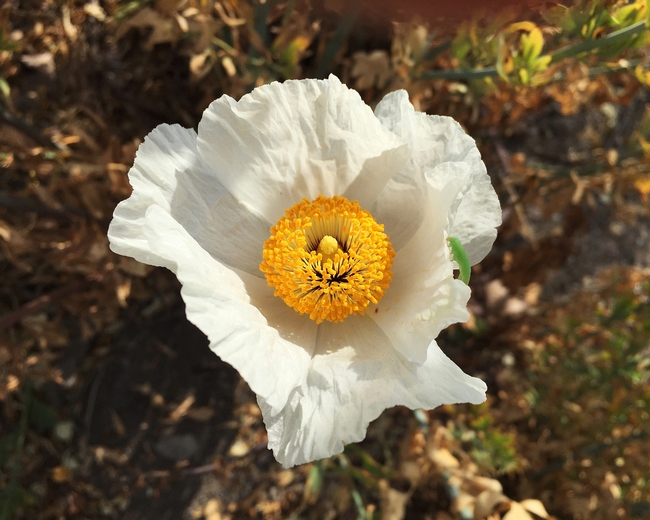
Matilija Poppy
By Deborah Light-Pacheco UCCE Master Gardener
Common name of plant: Matilija poppy
Scientific name: Romneya coulteri
Planting area: Sunset zones, 4-12, 14-24: H1
Size: 6-8 feet tall, spreading
Bloom Season: late spring into summer and fall with irrigation
Exposure: full sun
Pruning needs: cut to nearly the ground in late fall
Water needs: little or no water to moderate water
Snapshot: This shrubby perennial is a beautiful native of California and Baja California. The Matilija poppy, also known as tree poppy, can spread indefinitely by rhizomes. It has thick stems with grayish-green foliage. This plant produces enormous, 4”- 8” scented blossoms, with 5-6 white crepe paper-like petals. The stamen is bright yellow making the flower look like a fried egg. The flowers may be cut and used in a vase or as part of an arrangement. However, they should be cut in the bud stage as the flowers are short lived.
Planted on a hillside, they work as a soil binder preventing erosion and if used on a roadside, they can fill out a marginal area or provide a privacy screen. Their spreading habit can be considered invasive so use caution in your placement within a yard. The Matilija poppy is tolerant of a variety of soils and once established, they can grow freely and may need to be kept in check!
In the fall, cut nearly to the ground and new shoots will sprout after winter's first rains. Matilija is deer resistant and drought tolerant.
Though this plant is prolific once established, it is a challenge to propagate. If attempting to create more plants, try digging up rooted suckers or taking cuttings from the thickest part of the stem. Seeds are tricky to germinate.
Fun facts: this flower was once a contender for being named the California state flower. The name Matilija comes from Chief Matilija, a Chumash leader. To read a short story on the Chumash connection, see “Stories Behind a Few Favorite Flower Names” by Sarah Angelo https://ucanr.edu/blogs/blogcore/postdetail.cfm?postnum=46449


